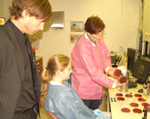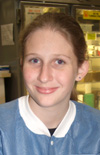Nail-biters may have ‘cleaner’ nails,
but ingesting more germs
by Mary
Helen YarboroughPublic Relations
A high school student’s discovery indicates that teenage nail-biters have the least germs under fingernails, and that short-clipped nails had more germs than long nails.
The study was conducted by a high school sophomore from West Ashley who was mentored by MUSC faculty. The conclusions should not be considered a pass for nail-biters, who may be ingesting the germs rather than leaving them under their nails.
The study by 15-year-old Jamie Yohn, who attends the Academic Magnet High School in North Charleston, also confirms the importance of frequent hand-washing in staving off germs. “People who washed their hands most often showed the least amount of germs,” Yohn said.
 Drs. Andrew Annand
and Lisa Steed mentor Jamie Yohn (seated) in the microbiology lab.
Steed explains bacterial colonies in petri dishes.
Drs. Andrew Annand
and Lisa Steed mentor Jamie Yohn (seated) in the microbiology lab.
Steed explains bacterial colonies in petri dishes.To answer her science fair project question: “Which fingernail length is most prone to bacteria?” Yohn worked in MUSC’s microbiology lab under the mentorship of Lisa Steed, Ph.D., director of Diagnostic Microbiology, and Andrew Annand, D.O., medical director of Kidney and Pancreas Transplantation.
“What I found was the exact opposite of what I had thought I would find,” said Yohn. “I assumed that because people’s mouths contain so many germs that nail-biters would have more germs under their nails. The opposite was true. In fact, people who clipped their nails short had the most germs under their nails.”
 Jamie Yohn
Jamie YohnTo make this determination, Yohn surveyed 30 fellow students about their hygiene habits and whether they bite their nails. Prior to swabbing a student’s nails, Yohn asked how many times the student had washed his/her hands that day. Then, using sterile cotton swabs, she swabbed under the nails of the person’s dominant hand and transferred the swab sample into a vial of saline solution.
The next day, she went to MUSC’s microbiology lab where Steed helped her transfer the collected samples in petri dishes. Each sample was placed on its own petri dish and labeled according to nail length. The dish also corresponded to information about the hand-washing habits of the person from whom the sample was collected.
Three sets of 10 samples were collected: 10 from short-clipped nails; 10 from bitten nails; and 10 from people with long nails. Yohn said that she was unable to make conclusions on what gender tended to have more or less germs, because those with long nails were female, and nail-biters and people with short-clipped nails were about equal among the sexes.
Once in the lab, Yohn viewed the growth from germs during a period of 48 hours, segregated the germ colonies, then used dyes to help determine what types of germs were present—bacillus or cocci—and how they would respond to hydrogen peroxide.
Though Yohn said it was difficult to determine the exact type of germs, she said that most of the germs found were staphylococcus, which she said was not surprising. “This is an organism that lives on the skin,” she said. The other types of germs found were varying types of bacillus. She said the germs could have included e-coli or hepatitis.
After the study, Yohn informed her fellow students of the results. “They were pretty disgusted,” she said. “They said, ‘I’m going to buy some Germ-X.’”
Not surprising, really
Annand said that he did not find the results surprising, but he is concerned that they indicate that nail-biting is a hedge against hand germs.
“People who bite their nails probably simply transfer the bacteria that would otherwise be present into their mouths, sort of the way a dog cleans its toes,” Annand said, “What’s worrisome to me is that ingesting these harmful bacteria by biting your nails is more apt to lead to systemic infection.”
So why were longer nails apparently less germy than short nails?
“The fact that longer nails had fewer bacteria than shorter ones is probably a matter of the nail bed being protected by the ‘umbrella’ of a longer nail,” Annand said. “Thus long nails lead to less colonization than short nails, while nail biters appear to have the cleanest nails but are probably just ingesting most of the bacteria and are thus ultimately the most prone to becoming ill.”
Steed said that the findings also make sense to her. “Without seeing the final data and the statistical significance (or lack thereof), it makes sense to me that short fingernails have the most colonies and bitten nails the least,” Steed said. “One explanation is sampling difficulties. Imagine how one could obtain a sample of the area under fingernails bitten down to the quick with a Q-tip? Along the same lines, yes, bacteria are microscopic, but a large population of bacteria cannot be developed in a space that receives frequent manipulation (pushing and pulling on the fingertip during regular activities) and frequent soaking in saliva, which has antibacterial activity. In my experience, people with long fingernails (and I don’t know how long the nails were in this study) tend to keep the area under their fingernails clean for aesthetic reasons. Long fingernails take effort to keep neat, clean, and long.” She said that sampling error was less of a concern in this part of the study.
Short fingernails, depending on how short short is, can be short because a person is fastidious but doesn’t like long nails, cannot grow long nails due to brittleness or other physiologic issues, or the person is a guy, Steed surmised. “I don’t mean that in a sexist way—guys can have great personal hygiene or poor personal hygiene, but long fingernails on guys are quite unusual,” she said, adding that sampling error increases as the nail gets shorter. “Short nails may just retain more dead skin or other matter in a kind of protected area. And if they don’t stick their finger into their mouths often, saliva won’t have any effect on reducing colonization.”
Steed said Yohn grew a lot of coagulase negative staphylococci, “which is normal skin flora and is supposed to be on your fingers and under your nails.”
Inspiration, challenge
Prior to her class project, Yohn said that she was not particularly interested in science. “I had always dreaded science class, but after this, [entering the field of science or medicine] is definitely a possibility. I had fun,” she said.
For years, Steed has worked with students like Yohn, serving as mentor and perhaps an inspiration to the world of science and medicine.
“Dr. Steed is fantastic,” Yohn said. “She is also hilarious. She was a great mentor and I learned a lot from her.”
Annand also praised Steed for her dedication to working with young people despite her heavy load as a lab director and MUSC microbiologist.
“Dr. Steed is a gift to the community as she whole-heartedly embraces and fosters students' interests like this with an enormous degree of compassion and skillful guidance,” Annand said.
This was the first time Annand had participated in the high school student mentoring program. He was approached by Jamie’s mother, Kat, because of his position with MUSC, to help confirm the scientific soundness of the science fair project.
“Jamie is an incredibly bright young girl and had several ideas in mind,” Annand said, “but [she] simply lacked the experience and scientific understanding she needed to conduct rigorous experimentation on her own.”
As her mentor, Annand said that he simply explained basic research concepts to her, “and saw to it that she gained access to the resources she needed at MUSC through the proper channels,” Annand explained. “This basically meant getting both the dean and the provost to approve of her presence at MUSC under proper supervision.
“Jamie conducted her own experiments with our guidance and supervision during critical junctures,” Annand said.
The student who washed hands the most (at least six times a day) showed no bacteria growth under fingernails, regardless of nail length.
Bitten nail germ samples showed an average of 16.6 germ colonies, while short-clipped nails showed an average of 370 colonies. People with long nails produced an average of 270 germ colonies from under their nails.
Germ colonies collected ranged from zero to 1,500 among the 30 people surveyed. The average fingernail produced between 10 to 50 colonies, or three to 700, depending on the nail length.
Half of the people surveyed reported washing their hands three times the day the sample was collected. One person from each group reported washing their hands at least six times that day.
Friday, Feb. 23, 2007
Catalyst Online is published weekly,
updated
as needed and improved from time to time by the MUSC Office of Public
Relations
for the faculty, employees and students of the Medical University of
South
Carolina. Catalyst Online editor, Kim Draughn, can be reached at
792-4107
or by email, catalyst@musc.edu. Editorial copy can be submitted to
Catalyst
Online and to The Catalyst in print by fax, 792-6723, or by email to
catalyst@musc.edu. To place an ad in The Catalyst hardcopy, call Island
Publications at 849-1778, ext. 201.